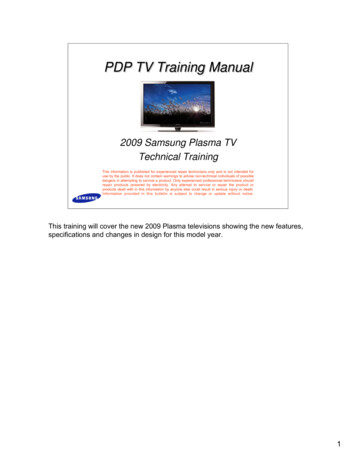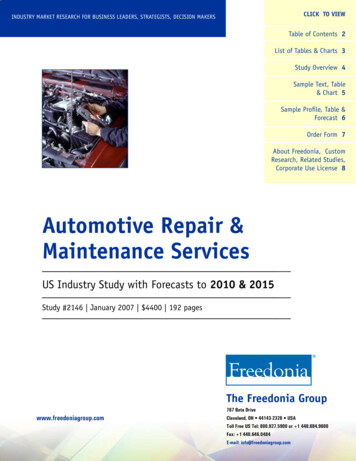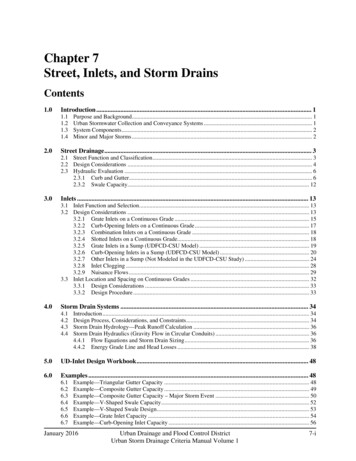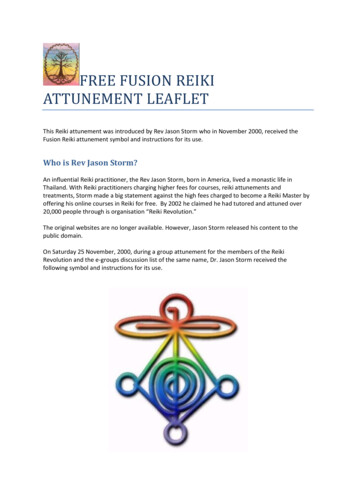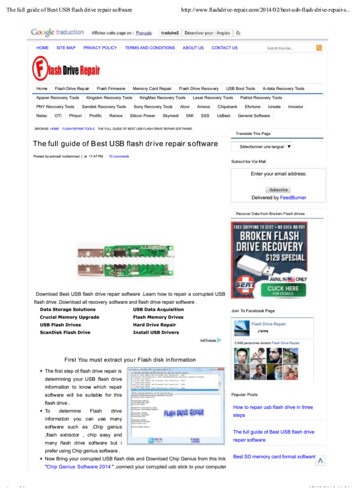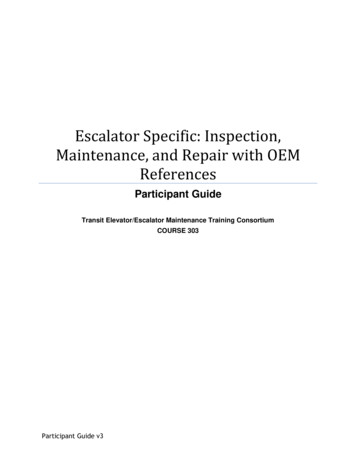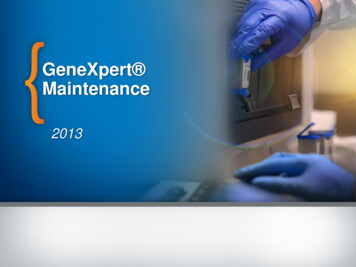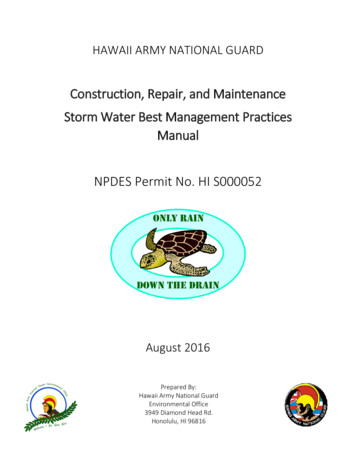
Transcription
HAWAII ARMY NATIONAL GUARDConstruction, Repair, and MaintenanceStorm Water Best Management PracticesManualNPDES Permit No. HI S000052August 2016Prepared By:Hawaii Army National GuardEnvironmental Office3949 Diamond Head Rd.Honolulu, HI 96816
Table of ContentsList of Acronyms . i1Introduction . 11.1Applicability. 1Table 1.1 Regulatory Requirements . 22Project Planning . 32.1FMO Project Planning . 32.2Contractor Project Planning . 42.3ENV Project Planning . 42.4Training . 43Non-Permitted Projects . 54NPDES Permitted Projects . 64.1Required Compliance Submittals . 64.2NPDES Permit Reporting . 65Storm Water Pollution Prevention Plan. 76Best Management Practices . 86.1Selecting Best Management Practices . 86.2Sediment and Erosion Control . 96.2.1Erosion Prevention . 96.2.2Perimeter Control . 96.2.3Inlet Protection . 106.2.4Dust Control . 116.2.5Stockpile Management . 116.2.6Soil Stabilization . 116.2.7Tracking Control . 126.3Waste and Hazardous Materials Management . 126.3.1Housekeeping. 126.3.2Portable Toilets . 136.3.3Concrete Waste. 136.3.4Hazardous Materials and POL . 136.3.5Hazardous Wastes. 146.3.6Painting and Paint Removal . 146.3.7Equipment Storage . 142
789Site Inspections . 157.1NPDES Permitted Projects Weekly Contractor Inspections . 157.2NPDES Permitted Projects Monthly HIARNG ENV Inspections . 15Corrective Action Policy . 168.1Critical Deficiency. 168.2Non-Critical Deficiency. 16Recordkeeping . 179.1During Construction . 179.2Post-Construction . 17List of AppendicesAppendix A – SWPPP Review ChecklistAppendix B – LID Project Review ChecklistAppendix C – SWPPP TemplateAppendix D – NPDES Construction Inspection Form3
List of AcronymsBMPsBest Management PracticesCFRCode of Federal RegulationsCISECCertified Inspector of Sediment and Erosion ControlCWBClean Water BranchDOHDepartment of HealthECBErosion Control BlanketENVEnvironmental OfficeFMOFacilities Management OfficeGGallonsHARHawaii Administrative RulesHIARNGHawaii Army National GuardLIDLow Impact DevelopmentMEPMaximum Extent PracticableMS4Municipal Separate Storm Sewer SystemNOCNotice of CessationNOINotice of IntentNPDESNational Pollutant Discharge Elimination SystemPMProject ManagerPOLPetroleum, Oil, and LubricantRCRAResource Conservation and Recovery Acti
RECPRolled Erosion Control ProductSECPSediment and Erosion Control PlanSMESubject Matter ExpertSOWScope of WorkSPCCPSpill Prevention, Control and Countermeasure PlanSWPPPStorm Water Pollution Prevention PlanTRMTurf Reinforcement MattingUFCUnified Facilities CriteriaUICUnderground Injection Controlii
Construction, Repair, and MaintenanceStorm Water BMP Plan, August 20161 IntroductionThe Hawaii Army National Guard (HIARNG) has prepared this Construction, Repair, and StormWater Maintenance Best Management Practices (BMP) Manual in accordance with NationalPollutant Discharge Elimination System (NPDES) Municipal Separate Storm Sewer System (MS4)permit HIS000052 (herein referred to as The Permit) Part D.1.d. (1) to provide guidance to allpersonnel, tenants, employees, and contractors involved in construction, repair or maintenanceactivities at HIARNG facilities regardless of project size and scope.1.1 ApplicabilityThe contents of this BMP Manual are herein considered to be minimum requirements for allconstruction, repair, and maintenance activities conducted on HIARNG facilities. Failure tocomply with the requirements of this manual will be considered a violation of The Permit andwill be enforced through the chain of command, contracting officer, and the HawaiiDepartment of Health (DOH). Table 1.1 provides a summary of the minimum requirements andSection 7 of this plan describes the HIARNG corrective action policy.1
Construction, Repair, and MaintenanceStorm Water BMP Plan, August 2016Table 1.1 Regulatory RequirementsQualifying CriteriaApplicable RegulationAll ProjectsHIARNG NPDES MS4Permit HIS000052, August 17, 2014HIARNG SWMP, February 2016,HIARNG Storm Water BMP manual,August, 2016Project footprint5,000 ft2 or greaterUnified Facilities Criteria(UFC) 3-210-10Low Impact Development (LID)Projects disturbing1 acre or more orwhich are part of alarger commonplan totaling 1 acreor more.Hawaii Administrative Rule (HAR)11-55, Water Pollution Control,Appendix C, December 6, 2013Requirements Minimize storm water pollutionto the Maximum ExtentPracticable (MEP). Maintain or restore predevelopment hydrology usingLow Impact Development. Submit Notice of Intent (NOI)Prepare a Storm Water PollutionPrevention Plan (SWPPP)Notify DOH 7 days prior toconstructionSubmit Notice of Cessation (NOC) 2
Construction, Repair, and MaintenanceStorm Water BMP Plan, August 20162 Project PlanningCompliance with federal and state storm water regulations begins during the preliminaryplanning stages of each project; communication between the Facility Management Office(FMO) and the HIARNG Environmental Office (ENV) prior soliciting projects is imperative toprevent NPDES permit violations, legal liabilities, and change orders.2.1 FMO Project PlanningAll HIARNG Project Managers (PMs) shall implement the following three (3) steps to assure allapplicable storm water regulations are communicated during the planning stages of eachproject:1. FMO shall include language in all Scopes of Work (SOWs) which contractually requirescontractors to comply with the HIARNG Construction, Repair, and Maintenance StormWater BMP Manual, August 2016; HAR 11-55 Water Pollution Control, Appendix C,December 6, 2013; and UFC 3-210-10 Low Impact Development, November 15, 2010.2. For projects disturbing one (1) acre or more, provide ENV with a Draft SWPPP and DraftNOI for review and acceptance at least thirty (30) days prior to submittal to the HawaiiDOH, Clean Water Branch (CWB).3. For projects disturbing one (1) acre or more, provide ENV with a Final SWPPP and a copyof the time-stamped NOI submittal to DOH.3
Construction, Repair, and MaintenanceStorm Water BMP Plan, August 20162.2 Contractor Project PlanningContractors, engineers, and consultants are encouraged to visit the project site prior topreparation of their bid proposals, SWPPP, and Sediment and Erosion Control design drawingsto assess site conditions, storm water flow patterns, project discharge points, soil types,measure project foot prints, plan for staging areas, and determine the appropriate BMP’s forerosion and sediment control.2.3 ENV Project PlanningThe ENV Water Quality Subject Matter Expert (SME) reviews the project SOW, design drawings,NOI, and SWPPP to assess compliance with federal and state storm water requirements and toensure LID and appropriate BMPs have been included. ENV uses the SWPPP Review Checklist(Appendix A) and the LID Project Review Checklist (Appendix B) to document and communicateregulatory deficiencies.2.4 TrainingENV provides training annually and as needed to all HIARNG staff with construction, repair, ormaintenance responsibilities. The training provides an overview of project planning, permit andregulatory requirements, storm water BMP selection, required inspections, and the correctiveaction policy.4
Construction, Repair, and MaintenanceStorm Water BMP Plan, August 20163 Non-Permitted ProjectsConstruction, repair, and maintenance activities conducted on HIARNG facilities that do notrequire a NPDES permit are still required to prevent storm water pollution to the MEP. Oftentimes the impact small projects can have on storm water is underestimated. All project SOWshould be provided to ENV for review and comment prior to solicitation for bid. Site specificBMPs for each project will be recommended by ENV during SOW review and should beincorporated into the project’s contract requirements.Examples of work activities that require BMPs Concrete Dry Wall Pressure Washing Cleaning Painting and Paint Removal Waste Water Pumping Landscaping Earth Work Equipment Maintenance Refueling Equipment Vehicle Washing Paving Dewatering Stockpiling5
Construction, Repair, and MaintenanceStorm Water BMP Plan, August 20164 NPDES Permitted Projects4.1 Required Compliance SubmittalsIn accordance with HAR 11-55, C, projects that require a NPDES permit must notify andsubmit compliance documents to the Hawaii DOH at the following three (3) points duringa project.MilestoneRequired Action30 days before start of constructionSubmit NOI via e-Permitting Portal7 days before the start of constructionVerbal or Written Notification to CWB7 days after end of constructionSubmit NOC via e-Permitting Portal4.2 NPDES Permit ReportingContractors and the FMO PM must notify HIARNG ENV immediately or as soon aspracticable at the 24 hour a day, 7 days a week Emergency Hotline at (808) 672-1013 if anyof the following occurs at their construction, repair, or maintenance project site: A spill of Petroleum Oil Lubricant (POL), hazardous material, or hazardous waste An illicit discharge of anything other than pure storm water from a NPDES permittedconstruction site (i.e. trash, debris, soil, chemicals, petroleum in stormwater)Contractors and FMO PM shall not report illicit discharges or spills to HDOH on behalf ofHIARNG without first notifying and receiving guidance from HIARNG ENV.6
Construction, Repair, and MaintenanceStorm Water BMP Plan, August 20165 Storm Water Pollution Prevention PlanFor projects that require NPDES permit coverage (see Table 1.1), a SWPPP shall be developed inaccordance with HAR 11-55, Appendix C, Section 7 and retained on site throughout the project.A draft SWPPP must be reviewed and accepted by FMO and ENV prior to finalization andsubmittal of the NOI to DOH. ENV uses the SWPPP checklist (Appendix A) to evaluate eachplan. A SWPPP template is included in Appendix C; contractors are encouraged to use thetemplate when practicable.The contractor responsible for architecture and engineering (A/E) shall prepare the SWPPPwhich includes sediment and erosion control drawings for each phase of construction per ArmyNational Guard General Facilities Information Design Guide 415-5, Chapter 6, Section 1, Division1, dated June 1, 2011.7
Construction, Repair, and MaintenanceStorm Water BMP Plan, August 20166 Best Management PracticesStorm water BMPs are methods or devices designed to minimize impacts to storm water. Thereare two main types of BMPs: structural and non-structural. Structural BMPs are devices orequipment used to minimize pollutants in storm water and non-structural BMPs are changes inprotocol, approach, and management practices used to minimize pollutants in storm water.Contractors must install all storm water BMPs in accordance with good engineering practices,manufacturer’s instructions, and design drawing specifications.6.1 Selecting Best Management PracticesContractors must select the most appropriate and effective BMPs for their project based on sitespecific conditions. Items to be taken into consideration when evaluating a site for BMP selectioninclude, but are not limited to: Storm water flow patterns Existing storm water infrastructure Soil types Annual precipitation Seasonal rainfall intensity Grade and slope Impervious and pervious surface types Nearby surface waters and impairment classifications Chemical use Hazardous material storageBMPs at construction and maintenance sites can be summarized into two categories:1. Sediment and Erosion Control2. Waste and Hazardous Materials Management8
Construction, Repair, and MaintenanceStorm Water BMP Plan, August 20166.2 Sediment and Erosion ControlAll projects that disturb soil, regardless of project size and NPDES permit status are required tominimize erosion and migration of soil from their project site to the MEP. Wind and water areresponsible for the majority of erosion typically found at construction and maintenance sites.Sites disturbing one (1) acre or more that require NPDES permit coverage must develop asediment and erosion control plan (SECP) per HAR 11-55, Appendix C.6.2.1 Erosion PreventionErosion can be prevented by minimizing disturbed areas and preserving existing vegetation onsite. When practicable, contractors should plan their project in phases to minimize the totalarea of exposed soil at any one time. Contractors must mark areas of vegetation to bepreserved.6.2.2 Perimeter ControlPrior to soil disturbing activities, contractors must install sediment controls around the perimeterof their sites to prevent illicit discharges. Dependent on site specific conditions, sediment can beretained using one, some, or all of the following structural BMPs. Contractors must maintainperimeter controls and shall remove sediment before it accumulates to one-half of theaboveground height of any perimeter control.6.2.2.1Silt FenceSilt fences are designed to contain storm water on site and cause ponding to allow depositionof sediments. Silt fences should not be used where concentrated flows occur unless reinforcedwith additional support. Silt fences should be installed with the posts on the downstream sideof the flow; on the upstream side of flow, the bottom tail of the silt fence should be trenchedsix inches down and six inches out then backfilled with soil.9
Construction, Repair, and MaintenanceStorm Water BMP Plan, August 20166.2.2.2Vegetated Buffer StripVegetation surrounding a site may be used as a form of perimeter control as long as thevegetated buffer strip proves to be effective at reducing runoff velocity and removing sedimentto prevent an illicit discharge. The minimum width allowed for a vegetated buffer when used asa primary perimeter control is 15 feet, the vegetated buffer strip shall not have a slope greaterthan 15%, and shall have a stand of dense vegetation maintained to a height of 3-12 inches.The vegetated buffer must be distinguished by flagging or other identifier to preventdisturbance from vehicles, machines, and use as a storage area.6.2.2.3Compost SocksCompost socks create a very small sediment containment system to allow for deposition ofsuspended particles. Compost socks should not be used where concentrated flows of runoffare anticipated such as drainage ditches, around inlets, or above/below culvert discharge.Compost socks should be installed to prevent runoff from flowing beneath and between socksby staking socks into the ground or anchoring and must overlap the ends of each sock by atleast six (6) inches.6.2.3 Inlet ProtectionExisting storm water infrastructure such as storm drains, catch basins, underground injectioncontrol (UIC) wells, curb inlets, and culverts should all be protected to prevent a discharge ofsediment into the MS4. Depending on the type of inlet, a site specific device should bedesigned to prevent an illicit discharge. Typical methods include installing filter fabric under thegrate of a storm drain or catch basin, and preventing flow to the inlet altogether using otherbarriers such as silt fencing or sand bags. Contractors are free to choose which inlet protectionBMP will work best for their site as long as it effectively prevents illicit discharges.10
Construction, Repair, and MaintenanceStorm Water BMP Plan, August 20166.2.4 Dust ControlApplication of water to minimize wind erosion shall be used on all exposed soils or anyconstruction, repair, or maintenance activity generating dust.6.2.5 Stockpile ManagementStockpiles of soil that are not being actively used shall be protected from erosion with a form ofperimeter control (see section 5.2.2).6.2.6 Soil StabilizationExposed soil should be stabilized with vegetation as soon as practicable during and afterconstruction, repair, and maintenance activities.6.2.6.1Rolled Erosion Control Products (RECPs)RECPs such as Turf Reinforcement Matting (TRM) and Erosion Control Blankets (ECBs) limit soilerosion, retain soil moisture, promote seed germination and protect seedlings during heavyrainfall or winds. RECPs are most appropriately used on sloped areas, however can be usedanywhere exposed soil exists. Before installing RECPs, all rills and gullies need to be smoothedand rocks need to be removed. When installing RECP on a hillside, the uphill edge of thematerial needs to be secured by trenching and/or anchoring and secured to the slope with anadequate amount of anchors. Seeding should be performed prior to installation of RECP.6.2.6.2SeedingWhen seeding an area to be stabilized, ensure success by preparing an appropriate seed bed,by incorporating fertilizer into the top soil, and irrigate until seed is established. In accordanceArmy National Guard General Facilities Information Design Guide 415-5 projects shall only usevegetation that is native, low maintenance, and drought tolerant.11
Construction, Repair, and MaintenanceStorm Water BMP Plan, August 20166.2.6.3MulchHydraulic mulch, straw, or hay can all be used to reduce soil erosion and to provide temporarycover of newly planted seed until established. Mulch must be applied at a density to cover80%-100% of the ground.6.2.7 Tracking ControlContractors must minimize the track out of sediment onto off site streets, sidewalks, and otherpaved surfaces by restricting vehicles to a designated egress designed to remove sediment fromvehicles prior to exiting the site. If sediment is tracked off site, the contractor must remove thesediment by the end of the same work day. Contractors using stabilized constructionentrance/exit to control tracking must meet the following specifications: Dimensions of the entrance/exit must be at least 50 ft. long and 30 ft. wide A geotextile filter fabric must be used under the aggregate Aggregate must be 2-4 inches in size and cannot be crushed asphalt Depth of aggregate must be 12 inches thick6.3 Waste and Hazardous Materials ManagementContractors must manage waste and hazardous materials at their site to minimize pollutants tostorm water.6.3.1 HousekeepingGeneral good housekeeping is required at all project sites. Contractors should keep their sitefree of trash and debris that could be swept away by storm water. Contractors are encouragedto consolidate equipment storage and staging areas to one location.12
Construction, Repair, and MaintenanceStorm Water BMP Plan, August 20166.3.2 Portable ToiletsAll portable toilets must be located away from storm water drainage features and vehicle trafficand secured to the ground when practicable.6.3.3 Concrete WasteProjects using concrete as a construction material or demolition activities generating concretedust and debris must use BMPs to minimize contact with storm water. When washing concretepump trucks and equipment, contractors must designate an impervious washout basin thatallows wash water to evaporate so that concrete debris can be properly disposed. Concretewashouts must be identified with a sign and cleaned out when volume reaches 50% of capacity.6.3.4 Hazardous Materials and POLAll hazardous materials and POL must be stored in leak-proof containers and either havesecondary containment or be stored under cover to prevent contact with rain water.All POL containers 55 Gallons (G) and above are subject to the requirements of title 40 of thecode of federal regulations (CFR) Part 112 Oil Pollution Prevention; if a contractor is storing1,320 G or more of POL on site for 6 months or more they must prepare a site specific SpillPrevention Control and Countermeasures Plan (SPCCP) to comply with 40 CFR 112.Anytime hazardous materials and POL are used, stored, or transferred on HIARNG propertycontractors must have spill supplies readily available.All spills of hazardous materials and POL must be cleaned up immediately and used absorbentmaterial shall be disposed in accordance with applicable Resource Conservation and RecoveryAct (RCRA) regulations.Contractors must call the HIARNG ENV Emergency Hotline at (808) 672-1013 to notify of allhazardous materials and POL spills that occur on their job site.13
Construction, Repair, and MaintenanceStorm Water BMP Plan, August 20166.3.5 Hazardous WastesContractors shall keep ENV apprised of any hazardous waste generation, accumulation, anddisposal of hazardous waste prior to and throughout construction, repair or maintenanceactivities. Contractors shall store all hazardous waste in sealed containers, which areconstructed of suitable materials to prevent leakage and corrosion, and which are marked,managed and disposed of in accordance with all applicable federal and state regulations. Allcontainers with hazardous liquids must be stored in appropriately sized secondarycontainment. All spills of hazardous waste must be immediately reported to the HIARNG ENVEmergency Hotline at (808) 672-1013.6.3.6 Painting and Paint RemovalContractors shall consider paint to be a hazardous material and must store containers inaccordance with section 5.3.4. of this plan. Contractors shall not rinse paint brushes or paintingequipment outside. If a facility discharges sanitary waste water to a cesspool or septic tank, thecontractor cannot rinse paint brushes and equipment on site. If a facility discharges sanitarywaste water to the municipal sewer system, contractors are allowed to rinse paint brushes andequipment into an approved sink.When removing paint, contractors must capture all paint chips and debris, characterize thewaste, and dispose of properly.6.3.7 Equipment StorageHeavy equipment that is not being actively used must be stored on an impervious surface whenpossible and must use a drip pan to capture all POL leaks.14
Construction, Repair, and MaintenanceStorm Water BMP Plan, August 20167 Site InspectionsAll project sites must be inspected regularly by the contractor and HIARNG ENV to confirmcompliance with storm water regulations.7.1 NPDES Permitted Projects Weekly Contractor InspectionsIn accordance with HAR 11-55, Appendix C, Section 9, contractors whose project sites arecovered under a NPDES permit must perform site inspections at least every seven (7) daysand within twenty-four (24) hours of a storm event of 0.25 inches. Inspectors must beknowledgeable in the principals and practices of erosion and sediment control andpollution prevention.7.2 NPDES Permitted Projects Monthly HIARNG ENV InspectionsAll construction, repair, and maintenance projects covered under a NPDES General permitfor construction activities as required by HAR 11-55, Appendix C shall be inspected priorto ground disturbing activities and monthly by a HIARNG ENV representative whom is aCertified Inspector of Sediment and Erosion Control (CISEC) or has at least two years ofstorm water construction compliance experience. The inspector shall use the HIARNGNPDES Construction Inspection Form located in Appendix D to assess the contractor’sadherence to applicable regulations and their SWPPP. At the end of each inspection, theHIARNG ENV representative and the site contractor representative review the inspectionresults together and discuss the cause of all deficiencies (if any). The site contractor isnotified of the deadline for corrective action and a follow-up inspection is scheduled forthe respective timeframe. The site contractor representative shall sign the inspectionform acknowledging the inspection results and the corrective actions required. A followup inspection is conducted to confirm all deficiencies have been corrected and theinspection form is signed and dated by both parties to verify the corrections have been15
Construction, Repair, and MaintenanceStorm Water BMP Plan, August 2016completed. HIARNG ENV retains copies of all construction inspections for five (5) yearsafter the permit is closed.8 Corrective Action PolicyHIARNG’s corrective action policy on storm water protection deficiencies is divided into twocategories; Critical, and Non-Critical. Storm water deficiencies can occur at any NPDESpermitted facility or construction site. If a contractor does not correct a storm water deficiencywithin the prescribed time-frame, the HIARNG Environmental Office will escalate the issuethrough the chain of command, contracting officer, and the Hawaii Department of Health(DOH).8.1 Critical DeficiencyA critical deficiency is any issue that poses an immediate threat of contamination to stormwater and/or surface water, or any issue that could cause an illicit discharge if a storm eventwere to occur. Examples of critical deficiencies are: spills that haven’t been cleaned up,concrete wash out not being used, lack of proper perimeter control, and unprotected stormdrain inlets. All critical deficiencies must be corrected within the same business day.8.2 Non-Critical DeficiencyA non-critical deficiency is any issue that does not pose an immediate threat of contaminationto storm water and/or surface water. Examples of non-critical deficiencies are: administrativeand recordkeeping violations, lack of secondary containment, or improper installation oferosion control devices. All non-critical deficiencies must be corrected within five (5) businessdays.16
Construction, Repair, and MaintenanceStorm Water BMP Plan, August 20169 Recordkeeping9.1 During ConstructionAll construction, repair, and maintenance projects covered under a NPDES General permitfor construction activities as required by HAR 11-55, Appendix C shall keep the NPDESpermit, SWPPP, SECP, and contractor weekly inspections readily available on site at alltimes. The contractor must also keep a record of all changes to the SWPPP and ensure thesediment and erosion control plan is updated to reflect current site conditions. The HIARNGENV maintains an inventory of all NPDES construction permits, SWPPP, and
August 2016 . 2 Table of Contents . Unified Facilities Criteria (UFC) 3-210-10 : Low Impact Development (LID) Maintain or restore pre - development hydrology using . Prior to soil disturbing activities, c ontractors must instal
